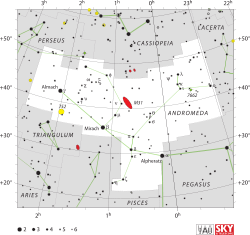Theta Andromedae

| |
| Observation data Epoch J2000 Equinox J2000 | |
|---|---|
| Constellation | Andromeda |
| Right ascension | 00h 17m 05.49885s[1] |
| Declination | +38° 40′ 53.8902″[1] |
| Apparent magnitude (V) | 4.61[2] |
| Characteristics | |
| Spectral type | A2 V[3] |
| U−B color index | +0.05[2] |
| B−V color index | +0.06[2] |
| Astrometry | |
| Radial velocity (Rv) | 0.9[4] km/s |
| Proper motion (μ) | RA: –49.35[1] mas/yr Dec.: -17.65[1] mas/yr |
| Parallax (π) | 10.56 ± 0.96[1] mas |
| Distance | 310 ± 30 ly (95 ± 9 pc) |
| Orbit[5] | |
| Period (P) | 1033+91 −77 days |
| Semi-major axis (a) | 25+32 −13 mas |
| Eccentricity (e) | 0.95+0.04 −0.40 |
| Inclination (i) | 69+8 −22° |
| Longitude of the node (Ω) | 263+50 −156° |
| Periastron epoch (T) | 238+343 −143 |
| Argument of periastron (ω) (secondary) | 89+175 −29° |
| Details | |
| Surface gravity (log g) | 3.95[6] cgs |
| Temperature | 8960[6] K |
| Metallicity [Fe/H] | +0.14[6] dex |
| Rotational velocity (v sin i) | 102[7] km/s |
| Other designations | |
| Database references | |
| SIMBAD | data |
Theta Andromedae (θ And, θ Andromedae) is the Bayer designation for a binary star in the constellation Andromeda. It is approximately 310 light-years (95 parsecs) from Earth,[1] with a visual magnitude of 4.6.[2] On the Bortle Dark-Sky Scale, this makes it visible to the naked eye from outside urban regions.
Theta Andromedae is a white A-type main sequence dwarf with an apparent magnitude of +4.61. It appears to be a binary star with a massive, possibly A-type secondary orbiting at a distance of around 1 astronomical unit.[5] A fainter companion is separated from Theta Andromedae by 0.06 arcseconds.[8]
Naming
In Chinese, 天廄 (Tiān Jiù), meaning Celestial Stable, refers to an asterism consisting of θ Andromedae, ρ Andromedae and σ Andromedae. Consequently, θ Andromedae itself is known as 天廄一 (Tiān Jiù yī, English: the First Star of Celestial Stable.)[9]
References
- 1 2 3 4 5 6 van Leeuwen, F. (November 2007), "Validation of the new Hipparcos reduction", Astronomy and Astrophysics, 474 (2): 653–664, arXiv:0708.1752
 , Bibcode:2007A&A...474..653V, doi:10.1051/0004-6361:20078357
, Bibcode:2007A&A...474..653V, doi:10.1051/0004-6361:20078357 - 1 2 3 4 Johnson, H. L.; et al. (1966). "UBVRIJKL photometry of the bright stars". Communications of the Lunar and Planetary Laboratory. 4 (99). Bibcode:1966CoLPL...4...99J.
- ↑ Cowley, A.; et al. (April 1969), "A study of the bright A stars. I. A catalogue of spectral classifications", Astronomical Journal, 74: 375–406, Bibcode:1969AJ.....74..375C, doi:10.1086/110819
- ↑ Evans, D. S. (June 20–24, 1966), "The Revision of the General Catalogue of Radial Velocities", in Batten, Alan Henry; Heard, John Frederick, Determination of Radial Velocities and their Applications, Proceedings from IAU Symposium no. 30, University of Toronto: International Astronomical Union, Bibcode:1967IAUS...30...57E
- 1 2 Goldin, A.; Makarov, V. V. (September 2006), "Unconstrained Astrometric Orbits for Hipparcos Stars with Stochastic Solutions", The Astrophysical Journal Supplement Series, 166 (1): 341–350, arXiv:astro-ph/0606293
 , Bibcode:2006ApJS..166..341G, doi:10.1086/505939
, Bibcode:2006ApJS..166..341G, doi:10.1086/505939 - 1 2 3 Hill, G. M. (February 1995), "Compositional differences among the A-type stars. 2: Spectrum synthesis up to V sin i = 110 km/s", Astronomy and Astrophysics, 294 (2): 536–546, Bibcode:1995A&A...294..536H
- ↑ Royer, F.; Zorec, J.; Gómez, A. E. (February 2007), "Rotational velocities of A-type stars. III. Velocity distributions", Astronomy and Astrophysics, 463 (2): 671–682, arXiv:astro-ph/0610785
 , Bibcode:2007A&A...463..671R, doi:10.1051/0004-6361:20065224
, Bibcode:2007A&A...463..671R, doi:10.1051/0004-6361:20065224 - ↑ Eggleton, P. P.; Tokovinin, A. A. (September 2008). "A catalogue of multiplicity among bright stellar systems". Monthly Notices of the Royal Astronomical Society. 389 (2): 869–879. arXiv:0806.2878
 . Bibcode:2008MNRAS.389..869E. doi:10.1111/j.1365-2966.2008.13596.x.
. Bibcode:2008MNRAS.389..869E. doi:10.1111/j.1365-2966.2008.13596.x. - ↑ (Chinese) AEEA (Activities of Exhibition and Education in Astronomy) 天文教育資訊網 2006 年 5 月 18 日